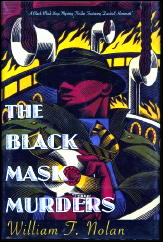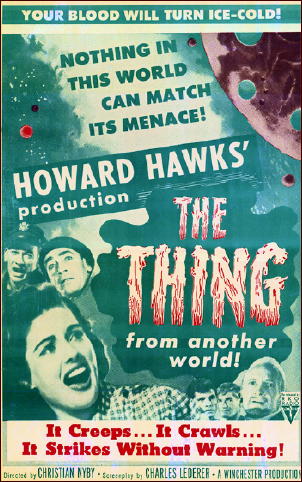December 2009
Monthly Archive
Sat 19 Dec 2009
Well, I take this personally!
SEVERE WEATHER ALERT
Forecast for Sat Dec 19 04:41 AM EST
Newington, CT
Winter Storm Warning
View Details Below
…WINTER STORM WARNING REMAINS IN EFFECT FROM 4 PM THIS AFTERNOON TO NOON EST SUNDAY…
THIS WINTER STORM WARNING INCLUDES MUCH OF SOUTHERN NEW ENGLAND EXCEPT THE NORTHWESTERN INTERIOR.
A CLASSIC WINTERTIME NOREASTER WILL CONTINUE TO DEVELOP OFF THE MID ATLANTIC COAST TODAY. IT WILL MOVE NORTHEAST TONIGHT AND LIKELY BE SITUATED JUST SOUTHEAST OF NANTUCKET EARLY SUNDAY MORNING. SNOW WILL SPREAD NORTHWARD IN ADVANCE OF THIS LOW AND WILL REACH THE WARNING AREA BY THIS EVENING. THE SNOW WILL BECOME HEAVY AT TIMES OVERNIGHT AND CONTINUE SUNDAY MORNING. THE LOW WILL PULL AWAY DURING THE DAY SUNDAY WHICH WILL ALLOW THE SNOW TO TAPER OFF AND END SUNDAY AFTERNOON.
STORM TOTAL SNOWFALL AMOUNTS ARE EXPECTED TO BE 7 TO 15 INCHES… WITH LOCALLY HIGHER AMOUNTS POSSIBLE. IN ADDITION…AS THE LOW APPROACHES TONIGHT…NORTH WINDS WILL INCREASE SIGNIFICANTLY… ESPECIALLY ACROSS EASTERN MASSACHUSETTS AND RHODE ISLAND. THIS COMBINED WITH HEAVY SNOW WILL CAUSE VISIBILITIES TO BE REDUCED TO UNDER A QUARTER MILE AT TIMES. SIGNIFICANT BLOWING AND DRIFTING OF THE SNOW IS ALSO POSSIBLE. IF WINDS LOOK TO INCREASE MORE THAN FORECAST ACROSS RHODE ISLAND AND EASTERN MASSACHUSETTS…MAINLY NEAR AND EAST OF THE I-95 CORRIDOR…AND UPGRADE TO BLIZZARD WARNING WOULD BE POSSIBLE LATER TODAY. TRAVEL IS NOT RECOMMENDED TONIGHT AND SUNDAY AS IT WILL BECOME DIFFICULT.
A WINTER STORM WARNING IS ISSUED WHEN AN AVERAGE OF 6 OR MORE INCHES OF SNOW IS EXPECTED IN A 12 HOUR PERIOD…OR FOR 8 OR MORE INCHES IN A 24 HOUR PERIOD. TRAVEL WILL BE SLOW AT BEST ON WELL TREATED SURFACES…AND QUITE DIFFICULT ON ANY UNPLOWED OR UNTREATED SURFACES.
UPDATE: 12-20-09. As far as the forecast is concerned, this storm was a dud. I don’t know about the rest of New England, but here in my driveway, the accumulation was only 5 or 6 inches. The word “only” is used only in context, you understand. If they’d predicted say 2 to 4 inches, this would have been huge.
But unless you have to travel, fires, hurricanes, mudslides and earthquakes are a lot more serious than a few inches of snow. As David points out in the comments, at least you can go out and play in it. Only once while we’ve been living in Connecticut has the governor had to shut the state down because of too much White Stuff.
In any case, my driveway is clear. It took me an hour and 30 minutes — and that’s about as long as I could go.
Fri 18 Dec 2009
In the Revised Crime Fiction IV, Raymond Chandler, Dashiell Hammett and Erle Stanley Gardner are denoted as series characters in a series of three novels by author William F. Nolan:
The Black Mask Murders. St. Martin’s, 1994.
The Marble Orchard. St. Martin’s, 1996.
Sharks Never Sleep. St. Martin’s, 1998.
None of the above are given credit as fictional characters in other detective novels. Hammett and Chandler both appeared in Chandler, by William Denbow, for example; and obviously Hammett appeared in Joe Gores’ Hammett.
Question: Are there other novels, ones I’m not thinking of, in which any of the above (including Gardner) appeared as fictional characters?
And as long as I’m asking, what other real life mystery writers may have shown up as characters in novels written by someone else? Josephine Tey, I know, in a couple of novels by Nicola Upson, but since they were published after 2000, they’re beyond the scope of CFIV. Disregarding the date, are there others?
Thu 17 Dec 2009
The last half of December is always the busiest time of year at the Lewis household, and so it is this year. There’s no way I can keep up the pace of recent weeks, and I really hadn’t better try. Expect only scattered postings over the rest of the year while other matters take precedence over reviews, overviews and other blogging activities, as enjoyable as they may be.
And my very best wishes for the holiday season to you all!
— Steve
Tue 15 Dec 2009
Posted by Steve under
Reviews[3] Comments
THE BACKWARD REVIEWER
William F. Deeck
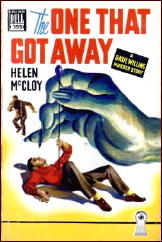
HELEN McCLOY – The One That Got Away. William Morrow, hardcover, 1945. Hardcover reprint: Detective Book Club, 3-in-1 edition, January 1946. Magazine appearance: Detective Novel Magazine, January 1947. Reprint paperback: Dell #355, mapback edition; no date stated [1949].
There may or may not have been an escape by a German prisoner of war in Dalriada, Scotland. Lieutenant Peter Dunbar, a psychiatrist who is interested in youth delinquency, is assigned by his commanding officer, Basil Willing — also a psychiatrist and a continuing character in McCloy’s novels — to find out if there was such an escape and where the German soldier might be hiding.
As soon as Dunbar arrives in the area, however, he becomes involved with the adopted son of a famous, albeit not much read, author and the author’s tripe-writing but best-selling wife. The boy keeps trying to run away from home for reasons unknown. In the most recent episode, the boy, in full sight of a watcher, vanishes on the moor.
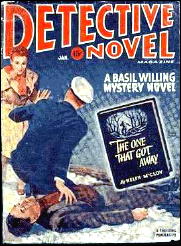
He also pulls the same trick later, more or less. Dunbar, who was supposed to have been watching him, is busy ogling a young lady.
Dunbar’s talents as a psychiatrist ought to be enhanced by his ability to read eyes. He knows when they have a twinkle in them, are wary and calculating, are full of tragedy. Since there are only two men in the area who could be the German escapee, if there is one, Dunbar’s ability to read the messages in eyes ought to make his task easy.
It doesn’t. After two deaths, one in a locked-room-type situation, Basil Willing has to step in and clear up the case. A good plot, some interesting characters, and enough misdirection to confuse both Dunbar and me.
Perhaps if he hadn’t fallen in love at first sight, he might have been able to do better. I didn’t have that excuse.
– From The MYSTERY FANcier, Vol. 9, No. 5, Sept-Oct 1987.
Tue 15 Dec 2009
REVIEWED BY WALTER ALBERT:
NICE WOMEN. Universal, 1931. Sidney Fox, Russell Gleason, Frances Dee, Alan Mowbray, Carmel Myers. Screenplay: Edwin H. Knopf, from a play by William H. Grew. Photography: Charles Stumar. Director: Edwin H. Knopf. Shown at Cinecon 40, Hollywood CA, September 2004.

Some wit on the convention committee had the inspired idea of scheduling this acid-tinged drama to follow the warmth of Sidney Franklin’s The Hoodlum (reviewed here ).
Sidney Fox is pressured by her family into accepting the marriage proposal of her father’s boss (Alan Mowbray), scuttling her plan to marry her true love (Russell Gleason). Frances Dee gives a splendid performance as the younger sister who coolly destroys her sister’s hopes for happiness, then flirts with her soon-to-be brother-in-law, further complicating the already impossible situation.
Mowbray, who initially appears to be a man with nothing but his business and his fiancee on his mind, has a skeleton in the closet, a girlfriend (Carmel Myers) who doesn’t want to lose her sugar daddy.
Mowbray is surprisingly cast as a romantic lead but he negotiates the tricky shoals with great skill, besieged on all sides by the “nice women” in his life. If it weren’t for the bite in the script and performances, this would be a forgettable soap.
But even with a happy ending that finally takes the teeth (fangs?) out of the drama, it’s still an engrossing pre-Code sexual drama of dysfunctional relationships.
Mon 14 Dec 2009
JIMMIE DALE, THE GRAY SEAL, by Frank L. Packard
An Overview by David L. Vineyard
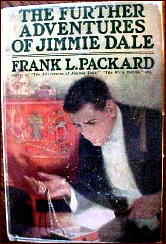
Few characters as obscure as Canadian novelist Frank L. Packard’s gentleman cracksman, Jimmie Dale the Gray Seal, have had the impact and long term import of this one. Almost unknown today, Packard and his creation not only exerted a tremendous influence on the pulps he came from, but established many of the tropes of the modern superhero in comic books.
From his secret lair, the Sanctuary, his multiple identities, and his calling card, a gray diamond paper seal, Jimmie Dale set the pattern for the mystery men and super heroes who will follow.
Jimmie first appeared in the May 1914 issue of People’s Magazine. He is the son of a wealthy safe manufacturer and himself an expert at all sorts of locks and safes. He is also noted for his sense of fun and adventure — which explains in part why he takes on the nom de guerre of the Gray Seal and breaks into the most difficult of safes, stealing nothing and leaving behind a gray diamond paper seal, the mark of the Gray Seal.

Normally he would probably have grown out of this stage, but a mysterious woman will change all that. It begins with a series of letters claiming to know all about the Gray Seal and threatening him with jail.
Soon enough the letters change and the mysterious angel begins to direct the actions of the Gray Seal to correct miscarriages of justice.
Of such things are great careers born.
Jimmie sells his father’s company and sets himself up as an idle playboy with the aid of the faithful butler Jason and his tough chauffeur Benson.
He creates the personae of Larry the Bat, a small time crook and informer, and Smarlinghue the drug addicted artist so he can penetrate the world of crime.
The police and press offer rewards for the Gray Seal; the underworld wants him dead. Jimmie squeaks by on brains, luck, and no little skill. His mysterious female angel calls herself the Tocsin, the Alarm. Soon enough she is revealed to be Marie LaSalle and Jimmie, already half in love with her, falls the rest of the way.
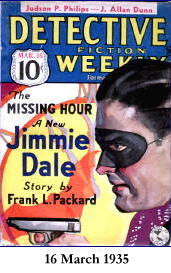
Not that there is much room for romance in the life of the Gray Seal.
Jimmie first appeared in 1914 and made his final appearance in Detective Fiction Weekly in 1935. His adventures are cleverly written melodrama penned by a writer who specialized in books about adventure with backgrounds in railroading, South Seas adventure, and the world of urban crime.
Among his better known books, The White Moll, and The Miracle Man (the latter a famous film with Lon Chaney). His books were frequently brought to the silent screen and his long career successful and rewarding.
But like many popular writers of his time — Harold McGrath comes to mind — he is largely forgotten today. Or would be, if not for Jimmie Dale, the Gray Seal.
Jimmie isn’t entirely original. He borrows elements from Eugene Sue’s Prince Rodolfe, from the Count of Monte Cristo, from Rocambole, from the Scarlet Pimpernel, from Raffles, from O. Henry’s grifters and Jimmy Valentine, from Arsene Lupin and others, but in Jimmie all the tropes of the mystery man and the super hero come together for the first time.
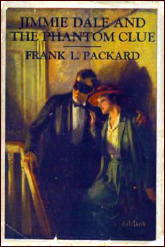 The Adventures of Jimmie Dale appeared in 1917. In 1919 The Further Adventures of Jimmie Dale came along. In 1922 the first novel, Jimmie Dale and the Phantom Clue came out in hardcover.
The Adventures of Jimmie Dale appeared in 1917. In 1919 The Further Adventures of Jimmie Dale came along. In 1922 the first novel, Jimmie Dale and the Phantom Clue came out in hardcover.
Jimmie Dale and the Blue Envelope appeared in 1930 and finally in 1935, Jimmie Dale and the Missing Hour. But as Robert Sampson points out in Yesterday’s Faces, Volume I: Glory Figures, the saga is really one long book, remarkably concise and suspenseful with the tension of a ticking clock.
Frank Packard died in 1942 while working on a new adventure of the Gray Seal.
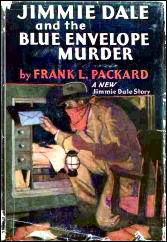
Much of our view of the mean streets and the urban ‘badlands’ comes from Packard’s books and their impact on others who followed in his footsteps. His tales are told in clean straight forward prose by a man of some culture and learning who understood the needs of storytelling and had something to say about salvation and redemption.
Virtually every fictional crime fighter who follows is within his shadow. He is simply one of the genre’s most important archetypes, and the transition figure from the quaint pre-war crime as game to the tough guns blazing sagas of the pulps, films, and comics that follow.
Jimmie may be a romantic and melodramatic figure, but he operates in the world of Hammett and Chandler. That said, Packard does not follow through on the social impact of crime in the same way as the hard-boiled school. He writes superficially about these subjects, but he writes well.
And his adventures are still worth reading. There’s little a modern reader has to forgive and much to praise. It is no small thing to say that Jimmie Dale can still be read for pleasure, not merely nostalgia or his historical importance.
The criminals lurk in the darkness, and the Gray Seal stands ready to strike, and in his wake every masked, caped, and spandex clad hero and mystery man stand ready to carry on his crusade. They are all in his debt, as are we.
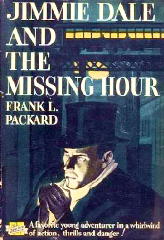
From Lamont Cranston to Bruce Wayne, from Richard Wentworth to Peter Parker, Jimmie Dale and the Gray Seal are where it all truly began, and more than worth revisiting to be surprised at just how much of the genre came fully formed from his adventures.
Note: Norvel Page, who took over the Spider from R.T.M Scott (creator of Aurelius Smith aka Secret Service Smith), was a particular fan of the Gray Seal and used many of Packard’s ideas in the Spider’s saga.
As Page greatly influenced both Michael Avallone and Mickey Spillane, so Jimmie Dale’s influence continues.
While there are other figures of equal importance, some which came before him, Jimmie brings all the elements together for the first time and thus holds pride of place.
Mon 14 Dec 2009
REVIEWED BY DAN STUMPF:
THE THING FROM ANOTHER WORLD. RKO Radio Pictures, 1951. Margaret Sheridan, Kenneth Tobey, Robert Cornthwaite, Douglas Spencer, James R. Young, James Arness. Based on the short story “Who Goes There?” by John W. Campbell. Directors: Christian Nyby, Howard Hawks (the latter uncredited).
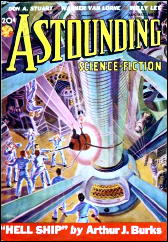
John W. Cambell’s classic short story, “Who Goes There?” (Astounding Science Fiction, August 1938, under his Don A. Stuart pen name) should be taught in Creative Writing courses for the way it propels a fast-moving story across a vivid background of bitter isolation.
Set at the South Pole, “Who” sketches the tale of a group of scientists discovering a flying saucer, complete with scary alien, frozen in the Antarctic ice for countless years. They lose the saucer but manage to bring the frozen monster back to their spartan base camp — with unexpected and very unpleasant results.
Campbell’s writing is terse and to-the-point, with every word exactly right, and none of them wasted. The characters may be a bit two-dimensional, but they serve their purpose and get out of the way of a story-line that stops for nobody. A classic of its genre.
“Who Goes There?” was filmed in 1951 by Howard Hawks, and I’m afraid all the best things about this fine movie have already been said, mostly by Robin Wood, in his book Howard Hawks (Doubleday, 1968.)
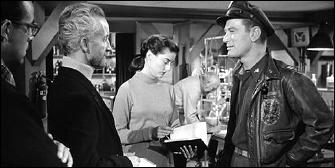
I can only echo his points about The Thing (from Another World) coming across as a quintessential Hawks film, which is pretty high praise wherever you take it.
Wood observes that the groups in this film (scientists or soldiers) are not so much cohesive units as ad hoc collections of individuals, each with something to contribute. He describes Margaret Sheridan as the equal of any of the men, yet intensely feminine, in the mold of other Hawks heroines, like Lauren Bacall and Angie Dickenson.
And he points out how the action, as in Rio Bravo, consists of gradually increasing tension, punctuated by short, sharp bursts of coordinated violence. Yes, The Thing is a brilliant film, fun to watch, and just I wish I’d said all those nice things about it before Robin Wood did.
Sun 13 Dec 2009
Posted by Steve under
Reviews1 Comment
A REVIEW BY MARY REED:
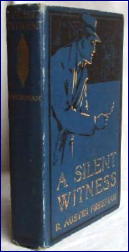
R. AUSTIN FREEMAN – A Silent Witness. Hodder & Stoughton, UK, hardcover, 1914. John C. Winston Co., US, hc, 1915. Reprinted many times since, including: Dodd Mead, hc, 1929; Pocket #184, pb, 1942.
Dr Humphrey Jardine’s narration treats of a strange chain of events that befell him when he was newly qualified, at a time when there were still horse-drawn cabs and the descent of dusk saw lamplighters at work.
His adventures began late one evening when he went for a stroll along Millfield Lane on the edge of London’s Hampstead Heath. He sees a corpse, a clerical gent going by his garments, lying further up the narrow thoroughfare but when he returns with police reinforcements a few minutes later the body has gone.

Naturally enough, the chaps in blue are politely sceptical about what Jardine saw or, as they see it, did not see.
Jardine returns next day to examine the lane and finds a suspicious stain on the fence near where the body had lain. He also picks up a tiny reliquary made of gold, its frayed silk cord suggesting it had been worn as a necklace or in some other way about its owner’s person.
Climbing up and looking over the fence, he sees obvious tracks leading away from the fence — taken all together, suggestive circumstances to say the least.
Dr Thorndyke suggests Jardine act as locum tenens for a doctor residing in Jacob Street, thus pitching the young medic into a positive whirlwind of odd goings-on, including a particularly inventive effort at murdering Jardine.
Thorndyke’s colleague Dr Jervis takes over Jardine’s position pro tem, and investigations get under way to find out who is assiduously trying to dispose of Jardine, a man with, so far as he knows, no enemies and with no relatives liable to benefit by his death.
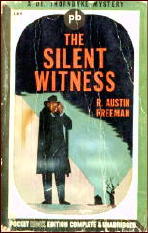
My verdict: The plot unspools into a web of disturbing incidents, unexpected meetings and re-meetings, attempted murders, and a deserted house which nonetheless tells a great deal as the novel rattles up hill and down dale, or rather lane, in a landscape through which move a pretty young artist with a ferocious aunt, a mysterious stranger afflicted with a rare eye disorder, a Jesuit priest seeking news of a missing friend, and a “downy bird” or two of both genders — not to mention a hidden portrait.
There is much following about of various people and sending of telegrams, and, of course, despite lack of clews, Thorndyke cracks the case, although not in time to … but no, I shall say no more.
Etext: http://www.gutenberg.net.au/ebooks03/0301591.txt
Sun 13 Dec 2009
Posted by Steve under
Reviews[2] Comments
Three More by EDWARD D. HOCH
by Mike Tooney:
For Part Two of this series, go here.
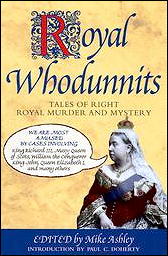
7. “The Day the Dogs Died.” First appearance: Royal Whodunnits: Tales of Right Royal Murder and Mystery, edited by Mike Ashley, Carroll & Graf, trade paperback, February 1999.
Bonaparte shook his head. “He died in the officers’ mess. If he was poisoned, the killer could be someone assigned to this very building, someone I see and trust every day. If an investigation needs to be conducted it must be done by an outsider.”
“I understand, but I am no investigator, only a ship’s doctor. And an enemy besides!”
Napoleon smiled slightly. “Because you are an enemy, you are the only one I can trust.”
COMMENTS: Lt. Garrison, ship’s surgeon on one of Admiral Nelson’s men-of-war, has been captured by the French and is languishing in a Cairo prison cell when he is summoned by General Bonaparte himself. One of Napoleon’s senior commanders has died under decidedly suspicious circumstances, and Bonaparte wants to know why.
Garrison, accompanied by a man who would gladly kill him if he makes a wrong move, turns detective and exposes not merely a murderer but also a drug smuggling ring.
A brown stain, hundreds of dead dogs, and streets too narrow for carriages all figure in his solution.
NOTES: This was Hoch’s contribution to an anthology of stories with the common theme of imperial skulduggery. Among the other contributors were Martin Edwards and Mary Reed & Eric Mayer.
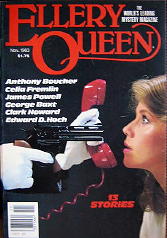
8. “Murder at the Bouchercon.” Ellery Queen’s Mystery Magazine, November 1983. Reprinted in Chapter and Hearse, edited by Marcia Muller & Bill Pronzini. William Morrow and Co., hardcover, 1985.
He knocked at her door and there was no answer. On an impulse, he tried the doorknob and it opened. A small piece of tape had been placed over the latch bolt to keep it from locking when the door was closed.
She was slumped over the writing desk near her bed. An ugly-looking hunting knife protruded from the center of her back.
COMMENTS: Mystery writer and amateur detective Barney Hamet is attending Bouchercon XIV in New York City to keep up acquaintances with his friends in the crime fiction publishing field when murder most foul is committed right in the middle of the convention.
The crime, as Barney soon learns, has something to do with Conrad Kazer, a reclusive mystery writer as elusive as Howard Hughes in his heyday — or, to be more precise, it has to do with the lucrative rights to Kazer’s works. To associate the murder with Kazer seems unavoidable because the victim leaves a dying clue: “Kazer con”.
Barney doesn’t know it at the time, but before he can leave Bouchercon he’ll come face-to-face with the murderer, an insane person with a sharp knife ….
NOTES: Barney Hamet also stars in one of Hoch’s few novels, The Shattered Raven (1969). Among the potential murder suspects at the convention are Otto Penzler, Chris Steinbrunner, Donald Westlake, Mary Higgins Clark, and Phyllis White.
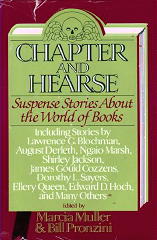
9. “The Great American Novel.” Ellery Queen’s Mystery Magazine, April 1975, as by R. L. Stevens. Reprinted in Chapter and Hearse.
I stepped around the back of the staircase and heard a movement in the dark. Then there was a flash of pain as something struck me across the head and I went down hard.
COMMENTS: Pete Traven works for a large New York publisher as a first reader of slush pile manuscripts. Like all editors, he harbors hopes of one day discovering that one-in-a-million submission that has Pulitzer Prize written all over it; and then it actually happens! It seems too good to be true, however, and as you can probably guess, it is.
Pete, moreover, never could have anticipated what complications would result from it: theft, impersonation, criminal conspiracy, assault and battery, and the threat of murder.
Sometimes, it would seem, book publishing can really be a cutthroat business!
NOTES: Pete is our viewpoint character, but “Stevens” (Hoch) throws in an interesting twist by having what seems to be a minor character solve the crime, so that we get not only a least likely suspect but also a least likely detective.
Sat 12 Dec 2009
DESTROYER. Columbia Pictures, 1943. Edward G. Robinson, Glenn Ford, Marguerite Chapman, Edgar Buchanan, Leo Gorcey, Regis Toomey. Director: William A. Seiter.
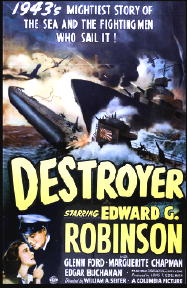
Some of the patriotric combat movies made during World War II while the fighting was going on overseas are still worth seeing today, but this isn’t one of them. Bits and pieces here and there, perhaps, but all good intentions aside, this isn’t one to go more than a few steps out of your way for.
I’ve checked on Google, and I’ve come up with two different ships called the USS John Paul Jones, but both came along a long time after World War II. Until I’m told otherwise, I’ll continue to assume the story told in Destroyer is quite fictional.
Working as a shipyard welder and construction boss in building the one in this story is Steve Boleslavski (a swaggering Edward G. Robinson), but when he re-enlists for the new hostilities with his former rank as chief bosuns mate, he finds that his knowledge of the new gunnery (as well as command techniques) are far out of date.
Resenting being pushed aside in the chain of command is Glenn Ford’s character, Mickey Donohue, who has the double misfortune of falling in love with Boley’s daughter (Marguerite Chapman). Fate and bad luck continue to haunt the ship and its crewmen until at last, demoted to mail boat status, there comes the chance to show what it (and they) can do.
Perhaps there is simply too much story here to be contained in only 99 minutes of film time, very close to A-movie standards. There’s the story of the ship; the story of Boley vs. Mickey; and the romance, which has the couple running off to elope only the third time we see them together, before we know that they are even talking civilly to each other.
There must have been a lot going on when the cameras weren’t rolling.
« Previous Page — Next Page »
